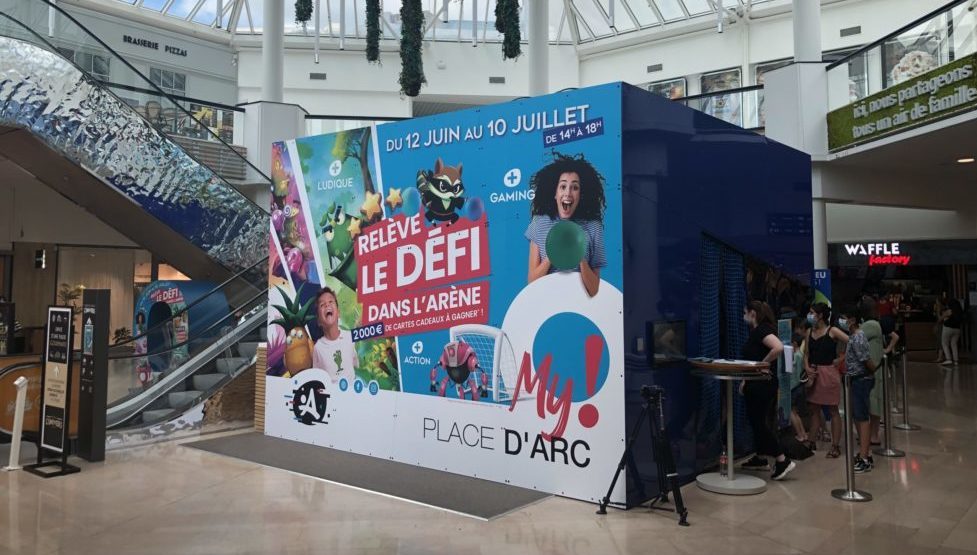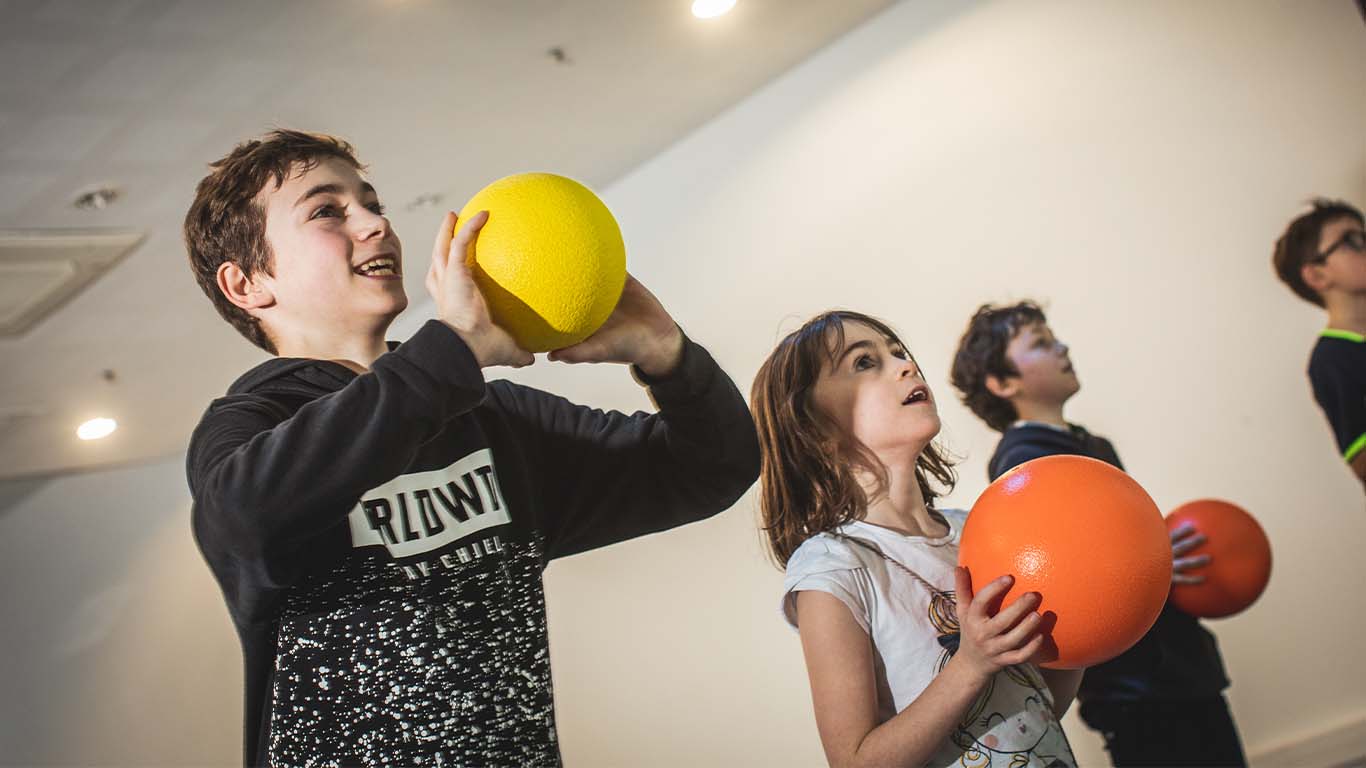What is Retailtainment?
To improve the shopping experience for visitors, facilitate access to leisure activities and reinvent and revitalize our businesses in accessible, innovative and entertaining ways.

Neo-One interactive and immersive play area - Place d'Arc shopping center, Orléans
Today, retailers are trying to reinvent themselves and revitalize their spaces to improve the shopping experience for visitors. Retailtainement is a trendy phenomenon that bears witness to this!
This word combines the terms"retail" and "entertainment".
This marketing concept involves transforming a shopping center or retail outlet into a place for entertainment or leisure.
By implementing a gamificationdigital screens and sensorial marketing, commercial establishments can increase the appeal of their spaces.
Birth of the concept in the United States
The Retailtainment concept has its origins in the United States, where shopping centers and major retailers have sought to differentiate themselves in the face of the rise of online retailing and changing consumer expectations.
As early as the 1990s, giants such as Disney Store, LEGO Store and shopping malls in Las Vegas and Dubai began integrating immersive elements to transform the act of shopping into a real experience.
One of the forerunners of Retailtainment, Joe Pine, co-author of The Experience Economy (1999)highlighted the idea that consumers are no longer just looking for products, but for engaging and memorable experiences. In response, brands have innovated by integrating interactive animations, immersive journeys and playful spaces into their points of sale.
Today, this trend is growing steadily and extending well beyond the United States, becoming an essential lever for revitalizing businesses and building customer loyalty in search of novelty and emotion.
The adoption of retailtainment in France
In France, retailtainment has gradually emerged as a response to the challenges facing shopping centers in the face of changing consumer habits.
With the rise of digital and online retailing, and the decline in footfall at physical points of sale, retail players have had to rethink their strategies for attracting and retaining customers.
As early as the 2010s, a number of French shopping centers, such as Les Quatre Temps in La Défense, Westfield Forum des Halles and Polygone Riviera, began integrating leisure facilities into their establishments. Cinemas, indoor parks, virtual reality areas, digitalized zones and interactive events have become essential elements in extending the time spent on site and enriching the customer experience.
Retailers themselves have followed this trend by focusing on immersive concepts: Lego Store boutiques with their construction workshops, experiential pop-up stores and sports stores offering test and demonstration areas.
The adoption of Retailtainment in France can be explained by the search for a new consumer model, where shopping becomes a fun and engaging experience. This phenomenon is part of a drive to make shopping centers more attractive, and to position them as genuine leisure destinations that go beyond the simple act of shopping.
The role of digitalization in making leisure accessible
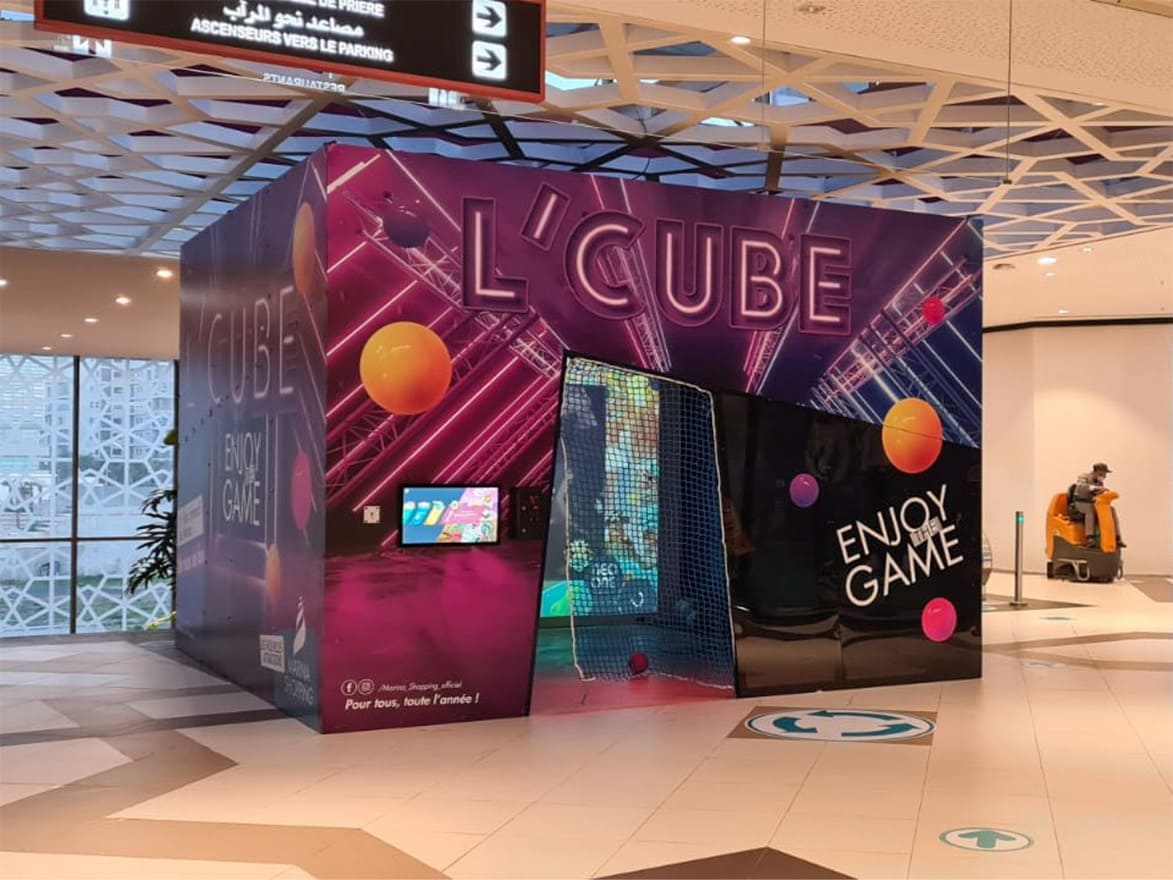
Neo-One interactive and immersive playground - Marina Shopping Center Casablanca (Morocco)
Retailtainment not only enriches the shopping experience, it also plays a key role in making leisure activities more accessible.
By integrating immersive and interactive experiences directly into commercial spaces, such as interactive wallsBy integrating immersive and interactive experiences directly into retail spaces, such as interactive walls, retailers are enabling visitors to discover new forms of entertainment without having to travel far. This trend meets a dual ambition: to attract and engage consumers while making the act of shopping more enjoyable, especially for families.
More and more shopping centers are using this approach to transform their spaces into true destinations, where the experience is as important as the checkout. For example, the Dubai Mall, the largest shopping center in the United Arab Emirates, incorporates an Olympic skating rink, a giant aquarium and even artificial waterfalls, offering much more than a simple shopping tour. This type of development, combining commerce and entertainment, is becoming a model for revitalizing commercial spaces and encouraging footfall.
In France, this trend is also developing with the emergence of interactive and digital leisure activities in shopping malls. Interactive playgrounds, augmented-reality animations, immersive immersive rooms or immersive immersive arenas make every visit unique and engaging. These digital installations transform visitors into active participants, strengthening their bond with the brand and extending their time in store.
Finally, digitalization plays a key role in this evolution. New technologies make it possible to offer leisure activities that are accessible, flexible and renewable over time. With ever more innovative and engaging experiences, retailtainment is becoming a real solution for re-enchanting shopping areas, attracting new visitors and energizing less-frequented areas.
Integration of animations and events
Animation and event organization are essential pillars of retailtainment, attracting visitors' attention and reinforcing their emotional commitment.
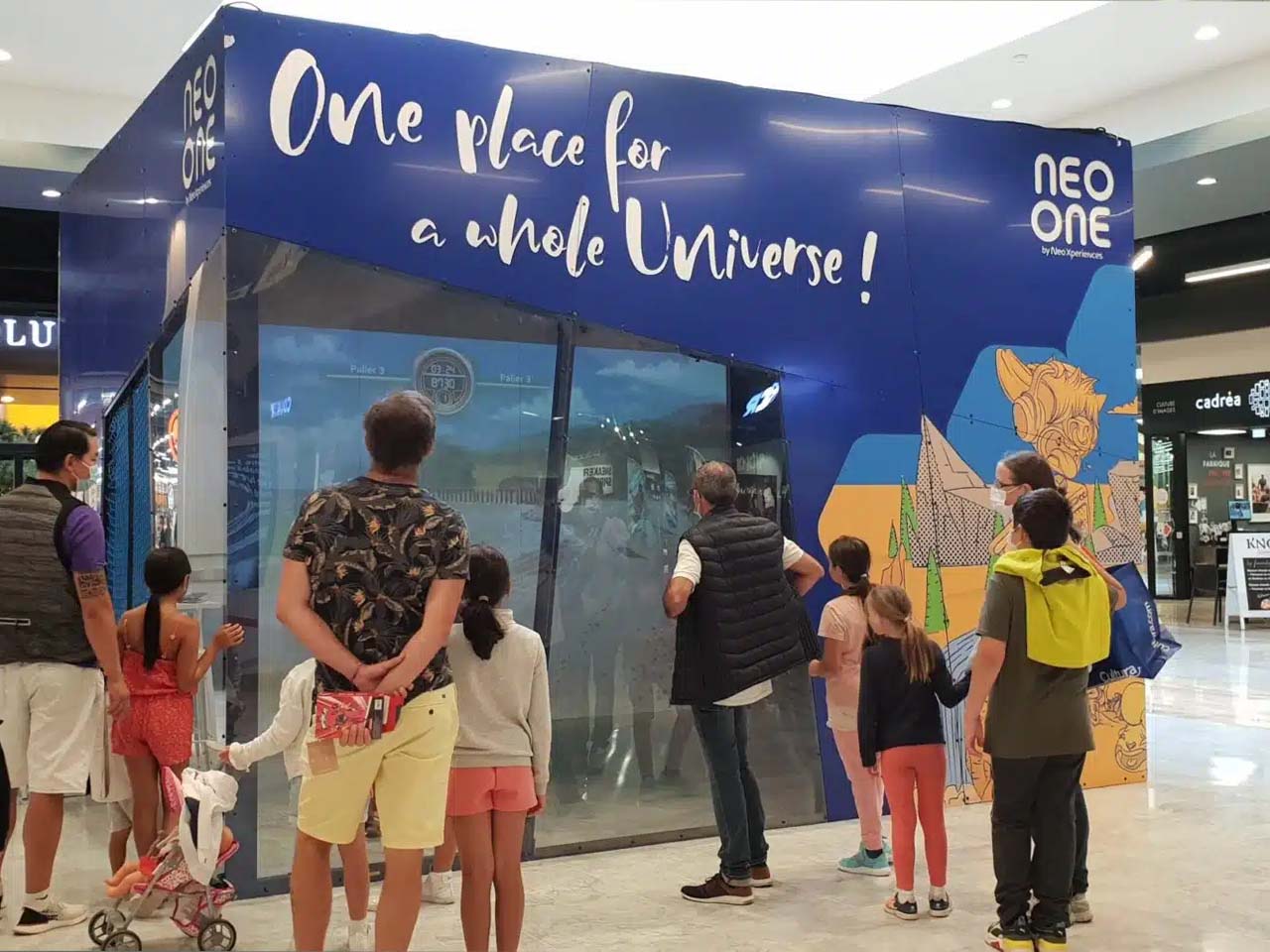
Neo-one animation - Grand Quartier shopping center, Rennes
At NeoXperiences, for example, we play an active part in this transformation by offering interactive solutions adapted to major events. At the Olympic Games, our interactive walls were installed in several fan zones, including Argenteuil, Sceaux, Vincennes and Club France, giving visitors the opportunity to test their agility and precision through immersive sports games. This type of animation encourages interaction, prolongs the time spent on site and creates a memorable experience for participants.
See our fan zone created for the 2024 Olympic Games
Our solution has also won over a number of shopping centers, including Marina Shopping in Casablanca and the Place d'Arc shopping center in Orléans. By integrating playful, interactive experiences, these establishments enhance their appeal and boost footfall, transforming shopping into a genuine moment of entertainment.
The use of immersive technologies
The rise of immersive technologies such as augmented reality (AR) and virtual reality (VR) has revolutionized retailtainment, offering new and engaging in-store experiences. These technologies enable brands to immerse their customers in interactive worlds, where the act of buying becomes a genuine sensory experience.
Many brands are exploiting these innovations: some fashion retailers offer augmented reality fitting rooms, while car dealerships allow customers to view and personalize a vehicle in 3D before buying.
At NeoXperiences, we have developed interactive and immersive solutions:
- Neo-One interactive wallThe Neo-One interactive wall transforms any space into a zone of play and interaction thanks to wall projection.
- Motion capture Neo-Moveto create immersive experiences by tracking users' movements using ultra-precise body-tracking technology.
These technologies enable shopping centers and stores to offer captivating experiences, promoting visitor engagement and brand recall.
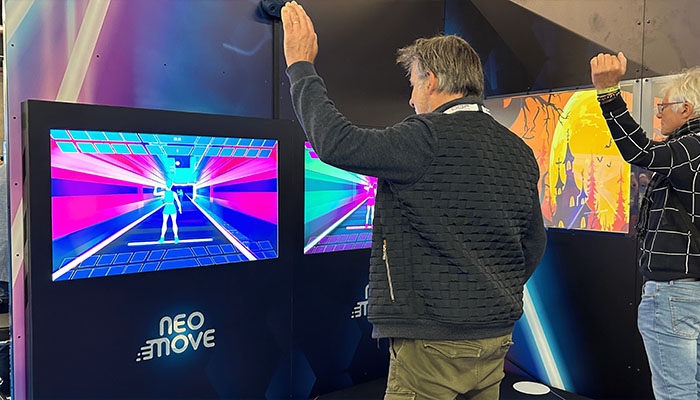
The benefits of retailtainment for companies
Retailtainment doesn't just offer consumers a fun experience: it also represents a real performance lever for companies. Brands can attract more visitors, extend their time on site, and boost engagement. Retailtainment also enables brands to differentiate themselves from their online competitors, by offering unique and memorable experiences that build customer loyalty.
Increased in-store traffic
Retailtainment plays an essential role in the appeal of physical stores, offering visitors an additional reason to visit. By integrating fun, interactive experiences, retailers are able to attract a wider audience and extend the time spent on site.
Devices such as interactive window displays and touch-sensitive kiosks attract passers-by and encourage them to enter the store. The more engaging the experience, the greater the interest and curiosity of potential customers.
Strengthening customer loyalty
In addition to attracting new visitors, Retailtainment helps to strengthen customer loyalty by creating memorable experiences and developing an emotional attachment to the brand. Consumers are increasingly looking for unique, engaging interactions with retailers, and an immersive, entertaining environment keeps them coming back for more.
Initiatives such as interactive loyalty programs, exclusive events and personalized experiences based on customer preferences are all effective strategies for building lasting customer relationships.
Differentiation in the face of online competition
E-commerce has profoundly transformed consumer habits, but it cannot offer the experiential and immersive dimension that retailtainment can. By integrating elements of play, discovery and sensory interaction, physical stores set themselves apart by offering a unique added value that online shopping cannot match.
Shopping centers and retailers that adopt this approach transform their spaces into living and entertaining places, where visitors come not just to buy, but also to enjoy an engaging and interactive experience. It is this strong competitive advantage that enables physical stores to remain attractive in the face of market digitalization.
The future of technology for commerce

Retailtainment is constantly evolving, and its future looks promising, driven by the rise of immersive and interactive technologies. Companies today are looking to push back the boundaries of the customer experience by integrating ever greater creativity and innovation into their retail spaces.
Artificial intelligence, mixed reality and real-time personalized environments are opening up new prospects for making the shopping experience even more fluid and immersive. In the future, stores could become true hybrid spaces, where the boundaries between commerce, entertainment and digitalization are blurred in favor of a more natural and engaging interaction.
Brands that know how to take advantage of these new trends and integrate interactive experiences will have a clear advantage in winning and retaining the consumers of tomorrow.
Other posts
Educational technologies stimulate access to knowledge, but where do they stand between pedagogical progress and attentional drift?
In a world where digitalization is transforming all sectors, sports clubs need to innovate to capture and hold the attention of their ...
Discover how marketing gamification can boost your business strategy with unique interactive experiences for your customers.
